![]()
![]()
![]()
Use LEFT and RIGHT arrow keys to navigate between flashcards;
Use UP and DOWN arrow keys to flip the card;
H to show hint;
A reads text to speech;
11 Cards in this Set
- Front
- Back
|
Describe the sympathetic nervous system by incliding its pre and post ganglionic components, and its function in:
a. pupil b. heart c. blood vessels d. skeletal muscle e. bronchial muscle f. GI g. Urinary h. male sex organ i. liver |
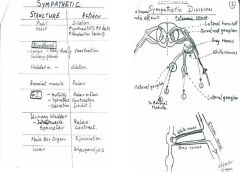
Tis is also called Thoraco-Lumbar Outflow. The sympathetic system is known as the fight, flight, fright and sex system (4 "F"s).
PREGANGLIONIC FIBERS: All fibers begin in the interomedial lateral horn (T1 - L2 or L3) and they go out into the system in 3 ways. -Preganglionc fibers leave with the ventral root fibers pass through the mixed nerve leave through the white rami communicantes and travel up and down the spinal cord and synapse on the postganglionic fibers which go to the effector organs. -2nd method: leave and go to outlying ganglia (splanchnic nerves) and then the postganglionic fibers go the the effector organ. -3rd: preganglionic fibers go to the adrenal medulla and at that level they synapse on the cells of the adrenal medulla which act as postganglionic fibers POSTGANGLIONIC FIBERS Postganglionic fibers from the paravertebral chain: 1. Enter the corresponding segmental spinal nerve via the gray rami communicantes 2. Travel to the autonomic effector organs. |
|
|
Describe the Parasympathetic nervous system by including its pre and post ganglionic components, and its function in:
a. pupil b. heart c. blood vessels d. skeletal muscle e. bronchial muscle f. GI g. Urinary h. male sex organ i. liver |

Now, the parasympathetic nervous system. After a big meal, the pupils are constricted, the heart activity is strong but slower, the bronchial is smooth muscle is constricted, the GI motility (peristalsis) is increased and the spinchters are open. The urinary bladder has contracted muscles and open sphincters so you can “pee.” MEMORY AID: First letter of parasympathetic system is “P” so you “pee” when the parasympathetic system is stimulated. Males get an erection when the Parasympathetic system is stimulated.
He would like for us to know the ganglion associated with the nerves of the Parasympathetic system. Nerve 3: Oculomotor – ciliary ganglion to the ciliary muscle Nerve 7: Facial – has two parts: preganglionic fibers go to the pterygopalatine ganglia and the postganglionic fibers go to the lacrimal gland. Pre-ganglionic fibers of the second portion go to submandibular ganglion the and the postganglionic fibers go to your submandibular and sublingual glands. Nerve 9: Glossopharyngeal – goes to the otic ganglion and they postganglionic fibers go to the parotid gland. Nerve 10: Vagus - 75% of the Parasympathetic system is in nerve 10. Nerve 10 goes to all of these organs (see picture) and then synapses on these tiny postganglion called the postsynaptic fibers which are intrinsic to the organ. -Remember that the Parasympathetic system has long pre-ganglionic fibers compared to the sympathetic system. Note also that the Vagus goes to all of these organs until it gets to the “sacred” zone and the parasympathetic innervation is the sacral parasympathetic. It is inside of the pelvic girdle. (Know That!) |
|
|
1. Illustrate the antagonistic effect of the ANS by comparing the 2 divisions?
2. What is the effect of a Sympathectomy? |
1. Most organs under ANS influence are innervated by both Symp. & Parasymp
Effects usually ANTAGONISTIC i) heart action – vagus = inhibition symp. = augment ii) Intest. Action - Vagus = augment - Symp. = inhib Slide 8: In certain parts of the body, the sympathetics may excite, causing the parasympathetics to have the antagonistic function and vice versa. Know that the systems work antagonistically! Slide 9: It’s easy to see that you can block the effects of one to increase the activity of the other. If you were to cut the vagus nerve then you know that the parasympathetic function is to inhibit the heart rate and the sympathetic system would be stimulated causing an increase in heart rate. Slide 10: In general, The functions of the Sympathetic Nervous System is generalized in character. It strengthens the defenses of the organism in danger, so that you can be prepared to fight or take flight. It also helps in extreme temperatures and water deprivation. Slide 11: The PSNS is localized in character. It is more conservative, protective, restorative. It inhibits heart activity and constricts the pupils. 2. Sympathectomize: block the sympathetic nervous system. It’s not possible to sympathectomize an animal, but you can block the sympatethics and under that conditon the animal can live indefinitely under lab conditions. The animal is then incapable of: i) hard work ii) stresses |
|
|
Chemical transmission in the ANS involves the release of what?
|
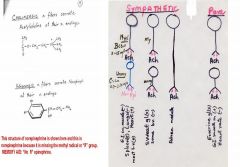
Chemical transmission in the ANS involves the release of acetylcholine and norepinephrine
1. Nerve fibers that secrete acetylcholine are called cholinergic fibers 2. Nerve fibers that secrete norepinephrine are called adrenergic fibers -Peripherally, all preganglionic neurons of the sympathetic and para-sympathetic nervous system elaborate at their terminals Acetyl Choline!!! -All postganglionic neurons of the parasympathetic nervous system elaborate at their terminals Acetyl Choline!!! -Postganglionic sympathetic neurons elaborate Nor-Epi except those to sweat glands and a few blood vessels of skeletal muscles which dilate in anticipation of exercise!! These elaborate Acetyl Choline at their terminals!!!! -The sympathetics in the adrenal medulla has only PREGANGLIONIC FIBERRS (Ach!!!) synapsing on the cells of the adrenal medulla that now act as if they were postganglionic fibers |
|
|
Describe the termination of acetylcholine (ACh) action?
|
Slide 21: This is important. KNOW THAT! For a substance to be an effective transmitter, it must be removed readily and recycled for re-use. ACh is broken down by acetylcholinesterase (rapid destruction). You get choline and acetic acid and the choline is recycled, taken back up to the nerve terminal and reused. The important thing here is the ACETYLCHOLINESTERASE!(ACh E)
|
|
|
1. What is very significant about the synthesis of catecholamines such as norepinephrine?
2. Once the Norepinephrine is released at the nerve terminal, how do you remove it? |
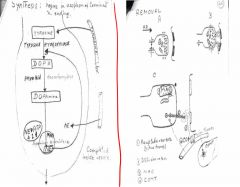
1. We are now dealing with the synthesis of the catecholamines. The synthesis of NE begins in the axoplasm and runs down the fibers and follows the cascade shown below. What is important here is that there is a feedback mechanism. When the NE is produced in adequate amounts, you can block the further production of DOPA from the tyrosine. THIS IS A POPULAR STEP TO ASK ABOUT!
There is a feedback mechanism here. When Norepinephrine is released in adequate amounts, a feedback inhibition will occur so that the adequate amount of NE will inhibit tyrosine hydroxylase so that NE will not be reformed. 2. Once the NE is released at the nerve terminal, how do you remove it? A. 50 to 80 percent of the removal of NE is by re-uptake (back up into the adrenergic nerve terminal by active transport)= (PRINCIPAL METHOD!). B. NE can also be broken down my MonoAmineOxidase (MAO) or by catechol –O –Methyl transferase (COMT). (Know that!) |
|
|
1. Describe the Cholinergic (Subsynaptic) Receptor?
2. Describe the Adrenergic receptor? |
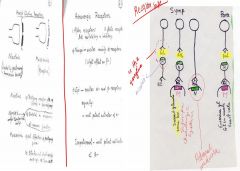
1. Cholinergic (Subsynaptic) Receptor
a. Nicotinic receptors in: i. autonomic ganglia in the neuromuscular junction ii. adrenal medulla -they are activated by ACh or nicotine b. Musacrinic receptors in: i. heart, smooth muscle, glands - they are inhib. in the heart -they are excite. in smooth muscle and glands -they are activated by ACh and muscarine -they are blocked by ATROPINE! 2. Adrenergic receptor a. Alpha 1 receptors = excite b. Alpha 2 receptor = inhibition c. Beta 1 receptor = excite d. Beta 2 receptor = inhibition NOTES: Slide 30: Remember this! This makes it easy for you. If it’s not an organ, then it’s not muscarinic. Cholinergic nerves act on cholinergic receptors. Muscles are innervated by either the parasympathetic nervous system or the sympathetic cholinergic system. KNOW THAT – even in skeletal muscle, the muscle that surrounds the blood vessel is smooth muscle and the receptor is muscarinic. -Nicotinic receptor is in the ganglia EFFECTOR ORGANS like in parasympathetic or adrenal medulla ALL EFFECTOR ORGANS by parasympathtic are MUSCARINIC receptors!!!!!!!!! Like GI tract, so increased activity here is due to parasympathetic so muscarinic receptor ALL EFFECTOR ORGANS of the cholinergic system of the sympathetic like sweating is MUSACRINIC receptors! In the ganglion it is nicotinic Adrenal medulla only gets acetylcholine because it only has pre ganglion, therefore it is nicotinic!!! |
|
|
1. Describe the convergence and divergence that takes place at the sympathetic ganglia and mention the potential changes at the ganglion?
2. What are "SIF" cells and why are they important? 3. What is unique about adrenal medulla? |
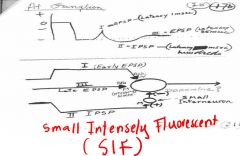
Sympathetic ganglia:
1. There is convergence and divergence btw several preganglionic axons on postganglionic neurons by each preganglionic axon sends collaterals that diverge on to several postganglionic neurons. - Potential changes at the ganglion are differentiated into three components: 1. A fast depolarization of short duration (about 1 msec) called the fast EPSP = may be blocked by NICOTINIC blockers 2. A slow hyperpolarization called the slow IPSP 3. slow depolarization of long duration called the slow EPSP = may be blocked by ATROPHINE acting on musacrinic receptors. 2. SIF cells = Small intensely fluorescent cells: These are interneurons that are intensely fluorescent cells, SIF cells and they are important because, THEY MODULATE THE OUTPUT OF THE OUTPUT NEURON and they elaborate DOPAMINE as the neurotransmitter at their terminals. 3. Adrenal medulla releases Epi (80 %) and Norepi (20 %) in order to maintain the normal tone of the sympathetic system because any increases in the normal levels of these neurotransmitters leads to an increase in heart rate and change in response to danger. NOTES: When you record the potentials at the ganglionic level, you record and EPSP then an IPSP then an EPSP. An actual recording could look like the drawing below, but what does this mean? #1 you have an EPSP that is nicotinic, but it you had used atropine, it would have blocked #2 and #3 because atropine blocks muscarinic receptors. So that one of the fibers that was converging on this postsynaptic location, you found that one of those fibers had a muscarinic component. If atropine blocked it, then it must be muscarinic. Atropine also blocked the inhibitory one. In the lab, you see some neurons, interneurons, which were intensely fluorescent cells, SIF cells, Remember the following: Small intensely fluorescent cells are elaborating dopamine at their terminals. |
|
|
Relate varicosities to neuroeffector innervation?
|
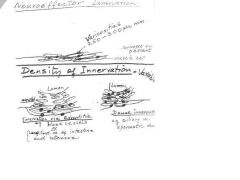
Here is a sympathetic fiber going to a number of smooth muscles. You know that with smooth muscle when they touch themselves, you get low resistance bridges which can help to spread smooth muscle information. Note that: here is a nerve fiber passing by these smooth muscles called varicosities and they function as synapses. The information, when it gets to the smooth muscle, can spread among the other muscles via synaptic contacts. The type of synapses that the variocosities make is called "synapse en pasant" = synapse in passing.
-Synapse en pasant = synapse in passing and it tells you the role of the varicosities so the transmitter substances are released from the blood stream by the adrenal medulla. Varicosity is a clump at any point in the nerve fiber Advantage is that one neuron may innervate many effector cells. |
|
|
Discuss the 2 mechanisms of regulation of neurotransmitter release?
|
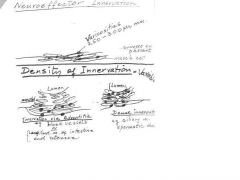
1. Regulation through positive and negative feedback involving presynaptic receptors
2. Regulation through reciprocal inhibition in organs with dual innervation e.g. cholinergic system acting on musacrinic receptors. NOTES: You see that , that is your swelling (varicosity), there is your fiber coming through , and transmitter substances are released into the synaptic cleft and into the effector organ. THERE WILL BE A QUESTION FROM THIS DIAGRAM ON THE EXAM!!! The NE is released into the terminal and when it is released it is going to act at the effector organ on either alpha or beta receptors. If the concentration of NE is too great, you can inhibit it using alpha pre-synaptic receptors. Pre-synaptic receptors can slow down the release of neurotransmitter. These are called the alpha-2 receptors. If the concentration of NE is not enough, Beta pre-synaptic receptors,not Beta 2, will increase the release of NE. Next one: All effector organs, with a few exceptions including the adrenal medulla, have dual innervation. Here we can say that we are wasting the “juice” when you have dual innervation of an effector organ If the desired result is a sympathetic effect and you are releasing ACh, a parasympathetic function. TO control it, the NE released into the synaptic cleft can act on presynaptic receptor in the parasympathetic system to bring about a reduction in the production of ACh, so u have tempered the effect of the ACh. The same is true when too much NE is being produced. presynaptic muscarinic receptors leads to the enhancement of release of transmitters acting on effector organs Not subsynaptic receptors! |
|
|
BONUS MEMORY AID
|
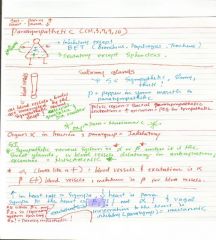
MEMORY AID:
Most systems function antagonistically. There is no rule about which is excitatory or inhibitory. Parasympathetic system: anything above the diaphragm will be inhibited except when you are dealing with the bronchus, esophagus, and trachea. Below the diaphragm, the parasympathetic is excitatory, except at the spinchters. Receptors: parasympathetic innervation of the GI system receptors. As long as it is parasympathetic it is muscarinic. Sympathetic system: alpha receptors are excitatory. ( a hastily written plus sign looks like an alpha.) |

